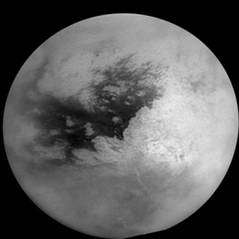Saturn's largest moon Titan resembles primitive Earth, Nature study

Astronomers say Saturn's largest moon, Titan, resembles a primitive Earth, complete with weather systems and geological activity.
The data came from the European Space Agency's Huygens probe, which landed on Titan Jan. 14, providing the first direct measurements from the moon.
Among the discoveries the ESA announced Tuesday:
-- Francesca Ferri and colleagues at Italy's University of Padova measured the temperature and pressure of Titan from the top of its atmosphere to the surface, which is a chilly minus -354 degrees Fahrenheit (-179 degrees Celsius). Ferri said Titan's atmosphere is divided into distinct layers, and lightning was observed.
-- Michael Bird and colleagues at the University of Bonn found Titan's winds blow in the same direction as the moon rotates, and close to the surface are at walking speed.
-- Marty Tomasko and colleagues at the University of Arizona described the dry riverbed and drainage channels seen during Huygens' descent -- evidence that liquid methane falls as rain or erupts from cryovolcanoes, periodically flooding the surface.
The research appears at the Web site of the journal Nature.
The probe, built by the European Space Agency, was named after the Dutch astronomer who discovered Titan in 1655.
Copyright 2005 by United Press International



















